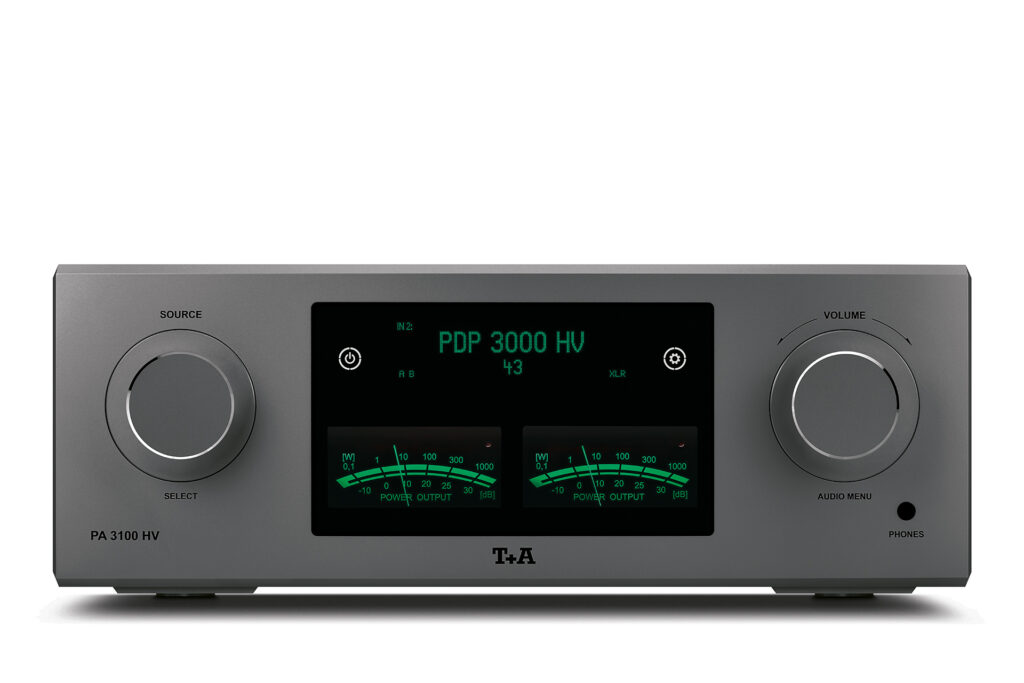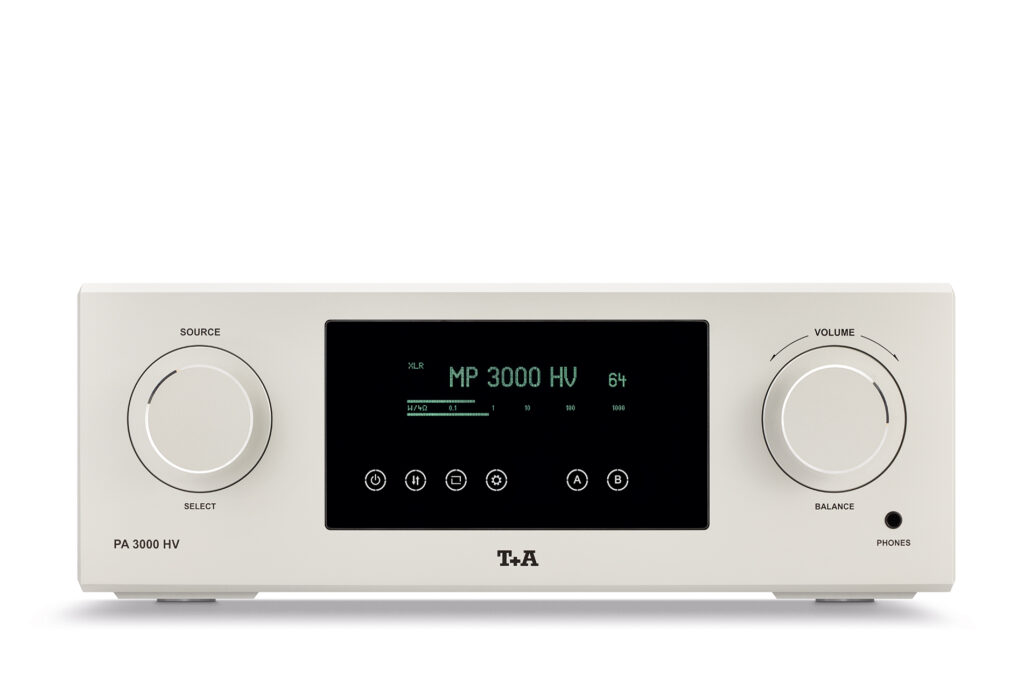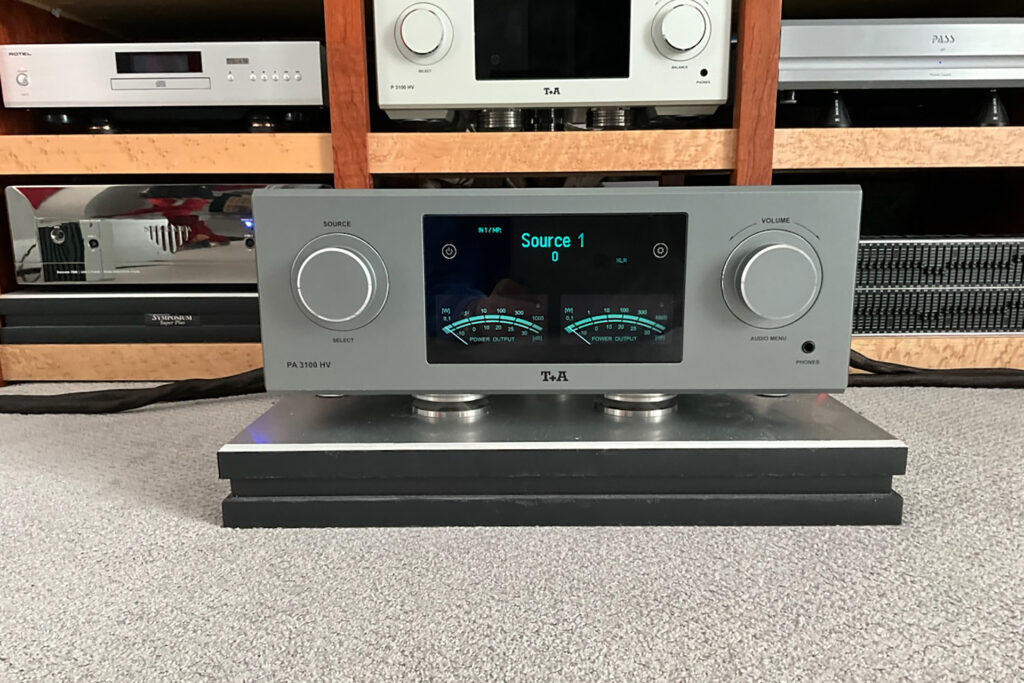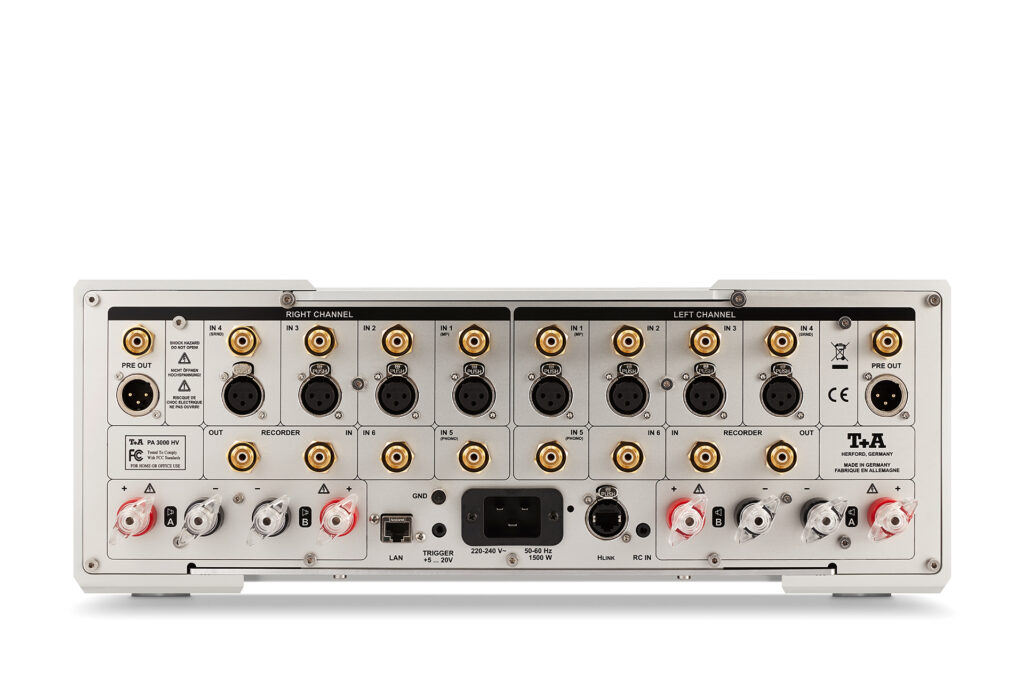Herford, Germany’s high-performance audio manufacturer T+A predominately operates under one guiding principle – “the appliance of science.” In fact, the T+A corporate name is an acronym for what the company enthusiastically describes as “theory and application.” With a staff of about 100 people, 16 of whom are full-time engineers, cutting-edge technology is squarely positioned at the forefront of their design and manufacturing ethos. T+A has become one of the better-known and most respected audiophile equipment manufacturers in Europe and is poised to make meaningful inroads into the U.S. market. In fact, this has already begun.
The High Voltage, or “HV,” line of components came about because, as a longtime manufacturer of tubed equipment, T+A wanted to see if solid-state gear could be made to sound more like tubes. After several years of research, the HV line was introduced. Because tubed equipment operates under much higher voltages than solid-state, T+A engineers reasoned, why not increase the voltage on the power supply rails of solid-state gear with the intended result of effecting a more tube-like sound? Using the appliance of science worked, and now, increased voltages on the rails of solid-state equipment are used by several of the world’s best component manufacturers as a path towards better sonics. This high-voltage operation is the cornerstone of HV in the T+A product line. The end result is a very lively, quite dynamic, yet neutral presentation, without any undue sonic influences from the component itself.
Relative to the purpose of this review, integrated amplifiers are gaining in popularity, because what they bring to the party is the ability to perform the duties of both a preamplifier and a power amplifier, and perhaps a DAC, phonostage and streaming section in one enclosure. In this review, we will take a much closer look into the T+A PA 3100 HV integrated amplifier. We will also attempt to try and answer the question of why this single box component should be chosen over separates.

What Makes the T+A PA 3100 HV Integrated Amplifier So Special?
- For circuit design, the T+A PA 3100 HV, and the entire HV product line, uses discrete, J-FET, differential amplifier technology, with almost zero negative feedback. Operational amps, or op-amps, are not used in the HV design. Using this technology, the HV product line claims to have extreme linearity and wide dynamic range, with exceedingly minimal levels of distortion.
- The T+A PA 3100 HV integrated amp is a fully balanced input to output dual mono design.Completely separate component parts for both left and right channels are housed in isolated compartments. A Toroidal transformer is completely enclosed to prevent electrical noise from entering the circuit. This helps reduce crosstalk and intermodulation to non-intrusive levels.
- The T+A PA 3100 HV Integrated Amplifier shares some of the design and even component parts of my reference amplifier and preamp, the T+A P 3000 HV preamp and A 3000 HV amplifier.
- The casework is manufactured to exacting standards in T+A’s Herford, Germany manufacturing plant. The internal frame is designed to separate and provide true isolation of the left and right channels for dual mono input to output configuration. T+A uses 10mm-thick aluminum plates, which are then machined to absolute flatness for internal bracing and separation. All internal machined and mechanical parts are non-ferro magnetic, including the fasteners holding everything together, and are used so that problematic magnetism issues will not compromise the sonics.
- An optional phonostage may be added at a cost of $1,700. This phonostage may be installed at the factory or by the dealer.
- With 300 watts RMS into eight ohms (380 intermittent), and 500 watts RMS into four ohms (700 intermittent), the T+A PA 3100 HV is easily capable of driving virtually any speaker configuration in existence – and with headroom to spare. My T+A A 3000 HV amplifier has these same power specs and more power available than I will realistically ever need or use. I can fill my audio room with 85 dB of sound and seldom use more than 30 watts of power. Soaring crescendos and explosive dynamics are therefore not a problem.
- Two large round knobs are front-mounted to change the source selection and volume. The right knob controls volume, and uses gold-plated contact relays and high-grade resistors to ensure precisely matched amplitude on both channels. It also may be used to call up other functions, such as balance, tone controls, loudness, and even room correction. The left knob selects sources and, secondarily, can activate a recording monitor.
- A very nice greenish front panel display shows the source selection, volume level, speaker output (A, B or both) and the input mode (XLR or RCA). The power button icon is also illuminated and operates in a soft touch manner. There are left and right VU meters, displaying wattage and decibel output. The display, as well as both meters, may be adjusted for different brightness levels, or turned off completely. LED-type lighting ensures long life.
- A headphone jack is conveniently located on the bottom right of the component.
- The amplifier section is Class-AB and operates in Class-A for about the first 6 to 15 watts (depending on the speaker load), then switches to Class AB. This is consistent with my A 3000 HV amplifier.
- The T+A PA 3100 HV uses a variety of protection circuits to monitor voltage spikes and dips, as well as any type of overload situation. It also monitors thermal temperatures and will shut itself off if any conditions outside predetermined levels are realized by the protection circuits.
- There are room for four inputs in both RCA and XLR configuration. Two additional inputs in RCA-only configuration are also available. Two pairs of speaker terminals per channel are available. They will accept both spade lugs and banana terminals. These terminals are rhodium-plated, typically offer better electrical contact than gold or silver, and are more expensive than either. Bi-wiring is easily facilitated with dual pairs of terminals per channel. An “H-Link” connection is also rear-mounted to allow multiple T+A components to be interconnected and controlled by one remote.
Why Should You Care About the T+A PA 3100 HV Integrated Amplifier?
One of T+A’s most basic marketing philosophies is fairness in pricing. While innovative and superior designs partnered with heightened performance are a real plus, not having to break the bank to pay for this innovation is greatly appreciated. Needless to say, the T+A HV lineup of equipment is certainly not considered budget-priced. However, when you look at some of the brands considered among the world’s best, it is not unreasonable to pay two to three times as much (perhaps more) for components with sonics that are very often only minimally improved over their T+A counterpart. Anyone who finds overall value and performance as having an alluring appeal will appreciate the T+A PA 3100 HV.
Some Things You Might Not Like About the T+A PA 3100 HV…
- T+A strongly recommends a minimum clearance of about 15 inches above and eight inches on either side of the chassis to ensure proper ventilation. If this amount of real estate is not available, thermal issues may arise. In my system, the A 3000 HV amplifier sits in front of the rack on a platform and four Stillpoints Ultra 6 footers, while the P 3100 HV preamp is rack-mounted. The PA 3100 HV was placed in the same location as the stereo amplifier.
- A 20-amp IEC19 male receptacle is used for AC power connections. This is done to ensure that adequate current and voltage are available to the unit. If the user has aftermarket power cords which employ a 15-amp IEC15 configuration, the cord cannot be used or must be re-terminated with a 20-amp female end. A power cord is included with the T+A PA 3100 HV.

Listening With the T+A PA 3100 HV Integrated Amp …
Having owned T+A gear for almost two years, I am very familiar with its sonic quality. The T+A PA 3100 HV was similar to my amp and preamp, in that it was quite dynamic, yet it also portrayed soft and delicate passages with finesse. While quite detailed, I was also impressed with its ability to present a rather expansive soundstage. Imaging and overall dynamics were not quite on par with my T+A separates, but nonetheless very enjoyable. And in playing a wide variety of music across a range of genres, I never got the feeling that one type of music was reproduced significantly better than another. Basically, the T+A PA 3100 HV made almost any type of music sound pleasing and enjoyable.
On the Billie Eilish track “Birds of a Feather,” from the release Hit Me Hard and Soft, I could not help but notice the overall easygoing, warm, lush presentation. Because the T+A PA 3100 HV integrated amplifier is easily capable of powerful dynamics, having such an ethereal and laid-back presentation, and doing so at an amplitude of 85 dB, made this track much more enjoyable. A delicate acoustic guitar perfectly meshed with Eilish’s at times almost minimalist vocals. On this track, Eilish tends to evoke a certain amount of passion in her vocal presentation, and this quality was in abundance with this amplifier. As the track proceeded, I heard a building of percussion and synthesizers, all presented with the exceptional imaging the T+A PA 3100 HV integrated amplifier is quite capable of reproducing. I will always tend to gravitate towards a more richly dynamic tune, but I must say that I found this song to be one I truly enjoyed during my time with the T+A PA 3100 HV amplifier.
In the spirit of full disclosure, my wife suggested I consider the track “Want You Back” by one of her favorite groups, Haim. From the release Something to Tell, “Want You Back” is essentially an upbeat, danceable pop tune. However, it also has elements of R&B and rock and, while at the very beginning it is somewhat slow, it really takes off when all three Haim sisters join in with stylish, well-executed harmonizing. Played with the T+A PA 3100 HV as the last stop before the speakers, this track was present with abundant and flourishing warmth, while concomitantly effecting an open, breezy style. Imaging was spot-on, and there was a palpable separation of instruments, which this integrated amplifier is easily capable of creating. Although basically a pop song, the bass response was sufficient to be noticed, yet not such that it became overbearing. I really enjoyed this track, as well as several others from the entire work. And I have my wife to thank for the heads-up.
Will the T+A P 3100 HV Preamp Hold Its Value?
In addition to highly advanced designs, T+A is also concerned about longevity. One of their stated goals is to design equipment that lasts for years, if not decades. This adherence to a long-life design is something of a two-edged sword. On the one hand, it makes the unit a high-value purchase. On the other hand, it quite possibly limits the used marketplace, because owners simply do not feel an immediate need to part with their HV equipment. In looking at the availability of used gear, the HV lineup of T+A products is not very plentiful. For these reasons, as well as incredible build quality and a sterling reputation, the T+A P 3100 HV should hold its value quite well.

What is the Competition for the T+A PA 3100 HV?
First, let’s look at the D’Agostino Progression Integrated Amplifier. Priced at $20,950 by itself, and $23,150 for the optional phono module, the Progression Integrated is slightly less than the T+A PA 3100 HV. Included are a scaled-down version of the famous D’Agostino retro inspired left and right channel meters. Delivering 200 WPC into eight ohms and 400 WPC into four ohms, the Progression Integrated is well equipped to handle most speaker loads. There are two RCA inputs and three balanced XLR inputs to accommodate almost any source. A very interesting adaptation is the Bluetooth remote. This eliminates the highly frustrating line of sight issues with infrared remotes and even outperforms radio or, for short, RF-controlled versions.
darTZeel Audio SA, headquartered in Geneva, Switzerland, is generally considered one of the world’s best line of amplifiers, preamps, and integrated amplifiers. While perhaps not as well-known, particularly in the U.S. as, say, CH Precision or Solution, their gear is nonetheless simply phenomenal. In this case, the darTZeel LHC 208 MKII integrated amplifier retails for $26,664. This may even be a real bargain when you stop to consider their big monoblock amplifiers are on the short side of $260,000. This entry-level integrated features 200 watts per channel into eight ohms and 300 watts per channel into four ohms. It has full streaming capability, and also has a built-in DAC. This is a component with digital in mind. It does not, surprisingly, have any XLR inputs – only RCA.
Lastly, we come to a comparison in which I was especially interested. In all honesty, it may not even be a fair comparison. But I believe it is relevant, especially for anyone who is torn between an integrated amplifier and separate components. I speak, of course, about the T+A A 3000 HV stereo amplifier ($24,275) and the matching P 3100 HV preamp ($23,750). Both the stereo amplifier and the preamplifier have been part of my permanent system for almost two years. Why then, would anyone want to spend just over $48,000 for separates when an integrated costs only $24,800? And this integrated is in the same family of products by the same manufacturer. Why indeed?
I found the separate amp and preamp to be marginally better in almost every category. Better dynamics and especially better imaging. I felt the separates were highly musical and slightly more intense, with a more full-bodied and robust presentation. A powerful presentation is a very apt description. However, I felt like the clarity and accuracy of the integrated were very consistent with my separates.
With the integrated, the sonic character was a bit more laid-back, or polite, if you will. The same global design philosophy is used for all three components. In fact, the amplifier and preamplifier sections of the integrated share some of the same internal component parts with the separates. The standalone preamp has two power supplies versus one and, with the extra room in both separate enclosures, and the same overall enclosure size for all three, more space may be dedicated to improved electronics, separating the left channel from the right and employing multiple levels of internal structures.
Conversely, this does not tell the whole story. In terms of overall sonics, how much better are the T+A separate amplifier and preamplifier than the integrated? After hearing both options, my answer is, definitely enough to notice, but not by a wide margin. The amount of this difference will certainly depend on the sources, speakers and the cables connecting everything together. In short, the decision is twofold. One: using separates provides individual internal parts such as power supplies and transformers. This reduces spurious noise and distortion from entering the signal chain. Separates also allow the individual replacement or upgrade of one device, as opposed to several in a one box solution. Or two: an integrated is less costly and, because one engineering team designed the component, it will logically operate with maximum efficiency and performance metrics. An integrated also uses less space and fewer cables. There are other notable differences as well. It is up to the user to figure out which option best suits their needs.
For my purposes, I will almost certainly consistently choose a separate amplifier and preamplifier – cost notwithstanding. But for anyone who would like a world-class component at a fair price with design and manufacturing excellence, the T+A PA 3100 HV is an absolutely valid and wise choice.

Final Thoughts on the T+A PA 3100 HV Integrated Amplifier …
The T+A PA 3100 HV integrated amplifier is a giant killer. When compared to some of the world’s best audiophile components, very often costing upwards of two or three times as much, this integrated amplifier consistently performs beyond expectations, and has even been described as “virtually indistinguishable” from several of its much more expensive counterparts.
And yes, I understand that an amplifier, even an integrated amplifier with a cost is just shy of $25,000, will not be of any interest to a lot of audiophiles. Price tends to eliminate a lot of very excellent products from many audiophiles’ roster of potential components. However, the price of the T+A PA 3100 HV, even if the phonostage is included, is quite reasonable for having multiple components in one unit. And when the level of craftmanship and build quality are also factored in, not to mention the remarkable sonics relative to the cost, the T+A PA 3100 HV could very easily be considered a very smart purchase. While I did go the route of separate components, had I originally decided to use an integrated amplifier, I could very likely be quite pleased with the T+A PA 3100 HV for many years to come. I feel this device does an excellent job of striking a balance between the technical and emotional aspects of a high-performance audio system. I can therefore unhesitatingly classify this component as worthy of very serious consideration and a comprehensive demonstration and evaluation by an authorized T+A dealer.




Great review, thanks.
Executing an optimal dual-differential, fully complementary Balanced design (XLR connectors) is not easy, and it nearly doubles the total Parts Count.
BTW, Praise and Honors to the Makers, for the 20A power cord! (I recommend sending it out for cryogenic processing–perhaps you can get an extra one, send it out, and then do a comparison!!! I can help if needed.)
Are there two stacked transformers in the PA3100HV? In the pictures I’ve seen (other sources) it looks like there is a large, single toroidal transformer. It takes two transformers to be dual mono. The pictures I’ve seen are from above an not on an angle, so it appears there is only one transformer. Just checking.